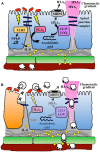Control of neutrophil inflammation at mucosal surfaces by secreted epithelial products
- PMID: 23914188
- PMCID: PMC3728559
- DOI: 10.3389/fimmu.2013.00220
Control of neutrophil inflammation at mucosal surfaces by secreted epithelial products
Abstract
The human intestine is a large and delicately balanced organ, responsible for efficiently absorbing nutrients and selectively eliminating disease-causing pathogens. The gut architecture consists of a single layer of epithelial cells that forms a barrier against the food antigens and resident microbiota within the lumen. This barrier is augmented by a thick layer of mucus on the luminal side and an underlying lamina propria containing a resident population of immune cells. Attempted breaches of the intestinal barrier by pathogenic bacteria result in the rapid induction of a coordinated innate immune response that includes release of antimicrobial peptides, activation of pattern recognition receptors, and recruitment of various immune cells. In recent years, the role of epithelial cells in initiating this immune response has been increasingly appreciated. In particular, epithelial cells are responsible for the release of a variety of factors that attract neutrophils, the body's trained bacterial killers. In this review we will highlight recent research that details a new understanding of how epithelial cells directionally secrete specific compounds at distinct stages of the inflammatory response in order to coordinate the immune response to intestinal microbes. In addition to their importance during the response to infection, evidence suggests that dysregulation of these pathways may contribute to pathologic inflammation during inflammatory bowel disease. Therefore, a continued understanding of the mechanisms by which epithelial cells control neutrophil migration into the intestine will have tremendous benefits in both the understanding of biological processes and the identification of potential therapeutic targets.
Keywords: MRP2; Salmonella; eicosanoids; hepoxilin; intestinal inflammation; lipid chemoattractant; lipoxygenase; neutrophil migration.
Figures

References
Grants and funding
LinkOut - more resources
Full Text Sources
Other Literature Sources

